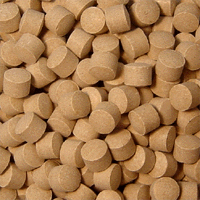Ego and Glycyrrhizin
There was a time when I pompously carried a tin of salty, black licorice wherever I went. Whether it was on my walk to class, through the mess hall, or down the dormitory corridor, I always rabidly shook my lil’ licorice tin and spastically chewed scottie dogs and black gummy spaceships. I wanted everyone to know that I was a dandy candy boy – I wanted everyone to know that my dandy candy boy preference was a confection considered repugnant by most Americans.
I didn’t eat licorice because I enjoyed licorice – I ate licorice because I enjoyed the egoist pleasure of being seen enjoying licorice. I wanted people to know that I was a true punk, that my candy was rife with argument and anti-american sentiment (licorice is more of a European taste than U.S.). I devoured with a voracious sugar appetite – a candy consumption theatre framing ironic homage to instant gratification, physical/mental obesity and addiction. If someone else liked licorice, I’d have to eat more acrid concentrations. If someone else liked dutch salmiak, I’d have to eat the double salt rounds. It was pure, licorice endowed egomania.
Despite my senseless self-righteousness, there was an honest curiosity for a candy which did not taste like other candies or dyed like other candies. Licorice is dark brown, sometimes pitch black, occasionally chalky in texture, harkening loose associations to coal, smoke, industry, plague [black death]. It has a cautious, approachable mystique, like the curious nature of shadows, inviting adventure into the unknown. Compare the darkness of licorice to other confectionary (even chocolate) in a candy shop and you will notice this “otherness”, either intensified by American dialogue on race and xenophobia or a translated Western exoticism. It serves an appropriate counterpoint to the vibrant, artificial optimism of pink bubblegum and aquamarine taffy. Licorice is made from a root that must be dug from deep within the earth, unlike sugarcane which is harvested from fields or an apple plucked from the sky.
Licorice contains a compound known as glycyrrhizin, an acid that is 50 times sweeter than sucrose (or simple table sugar). However, this sweetness hits the tongue very slowly and lingers longer in the mouth than table sugar. Sucrose is why we are never satisfied with a single skittle, gummy bear, whopper, or chocolate; the sweetness spikes instantly then quickly leaves the mouth, leaving the tongue craving another saccharine sensation. Sucrose is a one-dimensional sweetness. Glycyrrhizin, only found in licorice root, is a pleasure that is slowly cultivated through practice and patience. Its toothsome taste is regal, acquired, mature, and spans millennia of human culinary and medicinal use – from Ancient China to Antique Egypt (among the many treasures found in King Tutankhamun was a stockpile of licorice root). Licorice was used to cure headache, sore throat, asthma, and liver infections.
But these folk remedies didn’t pass Food and Drug Administration boards. In 2011, the FDA blacklisted licorice as a substance of great caution: BlackLicorice_FDA. Yes, licorice causes hypertension, chronic headaches, and occasionally heart failure and stroke. This blacklisting intensified the “otherness” of licorice, the separation and rejection from our ancient, sweet roots. Interestingly in 2012, only the following year, University of Würzberg in Germany heralded licorice as the medicinal plant of the year: article. To be American is to renounce licorice, to bury it back into the earth, to forget it, to demonize it. This anti-licorice epidemic is so integrated in our society that when I mention “licorice” most people think of the bright red candy rope:
These red candy ropes contain no licorice, no Glycyrrhizin, no sense of maturity or call to action. They are made with America’s staple subsidized crop, hyper-processed and refined, which is lobbied into all of our foods and drinks: High Fructose Corn Syrup. To be satisfied with redvine licorice is to be a passive member of society, to silently sit and be satisfied with the regular, unrewarding, and instantly gratifying.
Eating black licorice is a radical act. When you do so, you are welcoming curiosity and adventure – a sense of danger and intrigue. You will appreciate the patient act of overcoming the initial “bitterness” of black licorice to find its sustaining, super sweetness; a sensation longer lasting and more satisfying than bleached table sugar and soft drinks. You will appreciate the loving act of enjoying something you’d thought you’d never enjoy. You will begin seeking the other bittersweet aspects of life you otherwise overlooked.
***
Although some of my friends said I was a licorice addict, I didn’t agree with them – I wasn’t addicted to black licorice itself, but rather, the idea of black licorice. But the more I think about it, perhaps I was an addict; although there is no evidence for a physical addiction to glycyrrhizin, it is easy to find an underground culture of licorice lovers whose sentiments borderline dependency. You can effortlessly find black licorice ice creams, sauces, syrups, powders and other paraphernalia to fuel our sweet root fixation. Some licorice candies have added substances, such as ammonium chloride, a super salty flavoring agent. Licorice with high amounts of ammonium chloride is known as salmiak – Its taste is akin to salt lick and to novice licorice lovers, salmiak tastes more like a toxic chemical than an actual candy. I’ve gone down the salmiak path, first with single shots of ammonium chloride, and then the double salt coins. This stuff looks less and less like candy, and more and more like MDMA pills:

*
*
*
*
My mother knew I liked black licorice, but she didn’t know she was fueling my unrelenting desire for U.S. revolution and glycyrrhizin/ammonium chloride addiction. I would receive little “Mom Care Packages” in the mail which had the saltiest, darkest licorice you could imagine. My grandmother also knew I loved black licorice, so she went out of her way to find and package salty black licorice for me – it was the black tar of confectionary. I’d have boxes and bags of the stuff; I’d eat it wherever I went, I gave it to whoever was licorice curious – I saw myself as fueling the new candy counter-culture. I even found a turkish store which sold unprocessed, unadulterated licorice root, high in cloying glycyrrhizin. You could find me in the subway chewing away at sticks and twigs, sucking at bark, and picking root fiber from my teeth.
I don’t know where I stand with licorice today. Much like Allen Ginsberg who saw the fruit of mind-altering substances, he also saw the best of his generation destroyed by ravenous drug rapture, in need of an angry fix. LSD, marijuana, ketamine, and other substances lifted and freed the mid-century counter-culture generation from the chains of American Normalcy; but those substances also fueled the thriving movement’s collapse.


